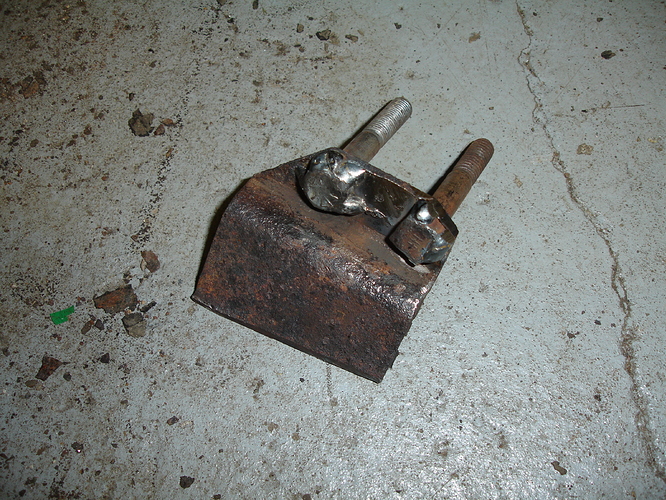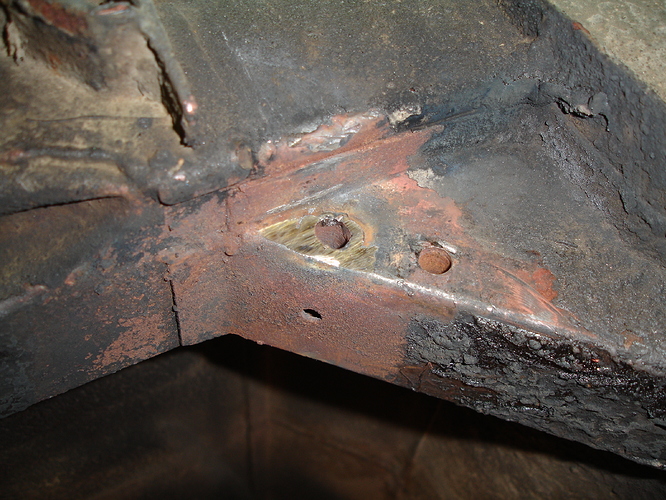Has anyone ever repaired a torn out hole in one of the 4 mounting locations for the cage on the car? If so, how did you repair it? Did you cut away the jagged area and use sheet metal–then drill the hole? If so what gage steel is that metal? Photos?
Tom- I can’t answer your question but would like to add that there is a steel spool piece brazed in between the two holes in the rear “frame”. It’s not just a plain thru-hole.
Yes, I know, and that also troubles me in terms of getting that piece in straight
Not knowing what the gauge is, but what you’re asking can be done.
Either with a tube welded in before the piece is welded into the car. Alternatively you drill the holes after welding the piece in, but one of the holes big enough for the tube to go through.
Any idea why that tube is in there? I’m thinking that it simply lines up the bolt so you dont have to search for the holes.
Tom
The tube is to give the frame rail strength. If it wasn’t there you could potentially squash it when tightening the bolts. There are tubes in the front frames as well.
since the bolts go through the hanger before they go thru the frame, wouldn’t that stop any squashing that might occur?
Depends on how much torque you apply to the bolts. If you run a bolt through the mount without it being on the chassis leg and tighten the nut you will pull the two sides together slightly.
Think of the chassis leg as a hollow square tube with holes in it. The bolts pass through both sides of the mount and clamp the tube firmly so there is no movement between the chassis leg and mount. If there were no tube in the chassis leg to prevent it from being distorted (mashed) by the tightened bolts you’d never have the mount tight enough against the chassis leg, there would always be play and further tightening would simply continue to distort the mount and chassis leg. The tube in there essentially makes the chassis leg behave more like a solid piece of metal.
makes sense---------we will see what kind of welding magic we can do to seal up this frame with the tube on it-------
Tom. I repaired one years ago on my ots. What I did was to get a tube that was the length of the width of the chassis leg plus the width of 2 moderately thick washers. Then I drilled out the washers to the diameter of the tube. Place the tube through the chassis leg and slid a washer on each end. The whole thing is then welded in place and any protruding weld ground off. The washers take up the space normally taken up by the shims. If the tear in the chassis leg is large you may need to use a mount as a template to line up the tube. Hope this helps.
Excellent. Great idea. Btw did you get any noise before you repaired it when driving over ruts?
It was 25 years ago I am lucky to remember what happened yesterday! I am pretty sure I found it when I was removing the subframe for rebuilding. I believe that the bolt was rusted solidly into the tube and the tube broke loose when I removed it. As a matter of fact I think I may have brazed the repair into place because I had no mig at the time and was afraid to use my stick welder on the thin metal.
One tube came loose when I was removing the suspension, but I was fortunate to not lose it into the frame and held it with wire.
Then I made this jig from an old mount so that I could keep the tubes in the correct location for welding.
I widened the hole in the frame slightly, then welded the tube back in place
Hope this helps
John North
S1 OTS
S2 Coupe
Without the tube, the load coming from the mounts would soley be on the sides of the frame. The tube spreads the load more evenly onto the bolts? Resistance towards the direction of squishing would reinforce the frame against sideway loads going through curves?
great work.
But how did you avoid welding the bolt to the chassis as well?
Two tack welds then remove the jig and weld away
John
Use a brass or copper bar. (Unless you’re brazing, or using SiliconBronze).
Crazy question, but how impt is it to have a “snug” fit of the bolt inside the tube? I’m having a heck of a time of finding a 5/16" ID tube--------and------what if the tube OD is thicker than original—don’t guess that matters??
I would say fairly important. There isn’t much flex in the arms of the cradle, so if one of the tubes is sloppy then the other two will be taking up the load (at least part of the time).
I guess you could drill a rod, or drill a tube with an ID which is slightly too small.
OD shouldn’t matter (providing you don’t run out of space inside the leg).
But isn’t the primary role of the tubes to prevent the chassis leg from being compressed? In Geoff’s repair suggestion I’d guess the ID of the two washers at each end of the tube is more critical than the tube diameter.


